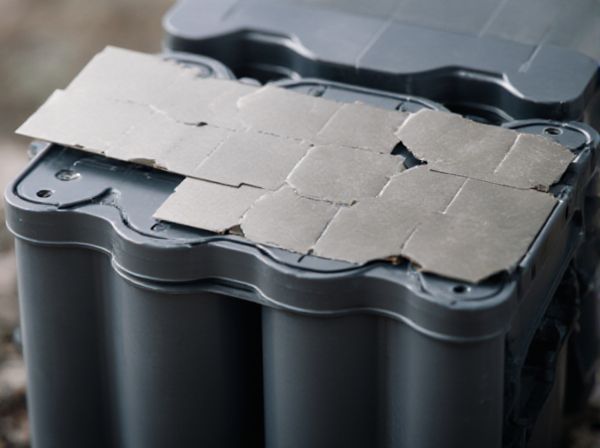
Photo illustration: Thin Plate Pure Lead vs Standard Lead
Thin plate pure lead offers superior corrosion resistance and higher conductivity compared to standard lead, making it ideal for high-performance applications like batteries and radiation shielding. Its refined structure enhances durability and thermal management, which can extend the lifespan of your lead-based components. Choosing thin plate pure lead ensures optimal efficiency and reliability in environments demanding strict material quality.
Table of Comparison
| Feature | Thin Plate Pure Lead (TPPL) | Standard Lead Battery |
|---|---|---|
| Plate Material | 99.99% Pure Lead | Lead Alloy |
| Weight | Lighter (up to 30% less) | Heavier |
| Cycle Life | Up to 3x longer | Standard lifespan |
| Charge Acceptance | High, fast recharge | Lower, slower recharge |
| Durability | Resistant to corrosion and vibration | Moderate durability |
| Cost | Higher initial investment | Lower upfront cost |
| Applications | High-performance, start-stop, deep cycle | Standard automotive use |
Introduction: Understanding Lead-Acid Battery Technologies
Thin plate pure lead (TPPL) technology enhances lead-acid battery performance by using ultra-thin plates made from high-purity lead, resulting in faster charge acceptance and longer cycle life compared to standard lead plates. Standard lead batteries typically feature thicker plates composed of lead alloys, offering moderate durability and slower charging capabilities. TPPL batteries are favored in advanced applications such as automotive start-stop systems and renewable energy storage due to their superior efficiency and longevity.
What Is Thin Plate Pure Lead (TPPL)?
Thin Plate Pure Lead (TPPL) is an advanced battery material known for its high purity and exceptional corrosion resistance compared to standard lead. TPPL's thin plate structure enables increased surface area, improving battery efficiency, longevity, and charge acceptance in automotive and deep-cycle batteries. This technology enhances battery performance by reducing internal resistance and extending cycle life, making it ideal for high-demand applications.
Overview of Standard Lead-Acid Batteries
Standard lead-acid batteries utilize lead plates submerged in sulfuric acid electrolyte, providing reliable energy storage for automotive and industrial applications. Thin plate pure lead (TPPL) batteries enhance performance by employing thinner, pure lead plates, resulting in higher charge acceptance, faster recharge times, and extended cycle life compared to conventional lead plates. While both use lead-based electrodes, TPPL technology offers superior power density and longevity, making it a preferred choice for demanding applications where rapid power delivery and durability are critical.
Key Material Differences: TPPL vs Standard Lead
Thin Plate Pure Lead (TPPL) features a high purity level of over 99.99%, offering superior corrosion resistance and enhanced conductivity compared to Standard Lead, which contains impurities that reduce performance. TPPL's microstructure is engineered for optimal grain orientation, resulting in increased mechanical strength and extended battery life. Standard Lead typically exhibits lower structural integrity and is prone to faster degradation under cycling conditions, impacting reliability in lead-acid battery applications.
Performance Comparison: TPPL vs Standard Lead
Thin Plate Pure Lead (TPPL) outperforms Standard Lead batteries in terms of cycle life and charge acceptance, providing up to twice the number of cycles and faster recharge times. TPPL batteries exhibit higher corrosion resistance and improved conductivity, which enhances their overall efficiency and reliability in deep cycling applications. Standard Lead batteries, while more affordable, typically suffer from reduced energy density and shorter lifespan, making TPPL the superior choice for high-performance and long-lasting energy storage solutions.
Cycle Life and Durability
Thin Plate Pure Lead (TPPL) batteries deliver superior cycle life compared to Standard Lead batteries due to their high-purity lead plates and unique thin-plate design, which reduces corrosion and enhances conductivity. TPPL technology enables more charge-discharge cycles, often exceeding 2,000 cycles at 50% depth of discharge, significantly outperforming standard lead-acid batteries. Enhanced durability makes TPPL batteries ideal for demanding applications requiring long-term reliability and sustained energy output.
Charging Speed and Efficiency
Thin Plate Pure Lead (TPPL) batteries deliver faster charging speeds due to their increased surface area and reduced internal resistance compared to Standard Lead batteries. This technology enhances charge acceptance, allowing TPPL batteries to reach full charge more quickly and maintain higher efficiency during rapid charging cycles. Consequently, TPPL batteries provide superior energy efficiency and longer cycle life, making them ideal for applications requiring frequent and fast charging.
Maintenance Requirements: Low vs High
Thin Plate Pure Lead (TPPL) batteries demand low maintenance due to their corrosion-resistant plates and stable electrolyte composition, resulting in extended service life and reduced need for water replenishment. In contrast, Standard Lead batteries require higher maintenance, including frequent electrolyte level checks and water additions to prevent plate sulfation and capacity loss. This difference significantly impacts operational costs and reliability, making TPPL batteries preferable for applications prioritizing minimal upkeep.
Typical Applications and Use Cases
Thin plate pure lead is predominantly used in manufacturing lead-acid battery grids for automotive and industrial batteries due to its excellent corrosion resistance and electrical conductivity. Standard lead, often alloyed or in bulk form, finds applications in radiation shielding, construction, and cable sheathing where mechanical strength and malleability are essential. Thin plate pure lead's superior purity enables enhanced battery performance, while standard lead provides versatility in heavy-duty and protective applications.
Cost Analysis and Value Proposition
Thin Plate Pure Lead offers a higher upfront cost compared to Standard Lead due to its refined purity and manufacturing process. The enhanced corrosion resistance and extended lifespan provide better long-term value by reducing maintenance and replacement expenses. Despite initial investment, the total cost of ownership favors Thin Plate Pure Lead for applications demanding durability and reliability.
 caratoz.com
caratoz.com